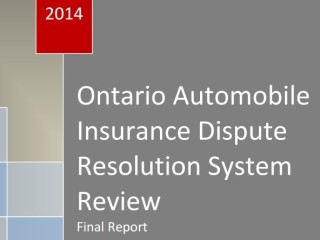Ms. Yatar was injured in a motor vehicle collision on February 7, 2010. TD Insurance (“TD”) initially paid certain benefits but denied payment beyond January 7, 2011 because it had not received a completed disability certificate. Soon after, TD completed IE assessments to determine entitlement to the same disputed benefits. All denials of benefits (income replacement and housekeeping benefits) were sent in 2011.
A FSCO mediation was held in January 2014. The failed mediation would have extended the limitation period by 90 days to April 2014. A Notice of Action was filed in Superior Court in March 2016 and dismissed on consent in March 2017. A LAT application was commenced in March 2018 and dismissed as statute-barred based on the two-year limitation period in April 2019. The LAT confirmed its decision on reconsideration in April 2020.
Of the three denial letters sent to the applicant in January, February and September 2011, the earliest one (January 2011) had a dispute resolution form attached to it and the adjudicator was satisfied that it was a valid denial as required by Smith v. Co-operators General Insurance Co., 2002 SCC 30. The adjudicator found that, as a result of the valid denial, the applicant was aware of the dispute resolution process and, while the FSCO mediator’s report would have extended to limitation period by 90 days, the limitation expired in April 2014. The LAT application having been commenced in March 2018 was well beyond the limitation period.
Ms. Yatar commenced a judicial review application in May 2020. She had also commenced an appeal before the Divisional Court and asked for both the appeal and application to be heard together.
The Divisional Court considered both the appeal and application for judicial review. It dismissed the appeal because the appellant did not raise a question of law. Whether the denial was clear and unequivocal and whether the appellant was advised of her right to dispute the insurer’s denial were questions of mixed fact and law and thus, not appealable.
With respect to the application for judicial review, the Divisional Court noted that judicial review is a discretionary remedy and that it would exercise that discretion only in “exceptional circumstances.” It considered whether there was an adequate alternative remedy that would preclude resorting to judicial review. It noted that the Supreme Court’s decision in Strickland v. Canada (Attorney General), 2015 SCC 37 at para. 42 had said that “neither the process nor the remedy need be identical to those available on judicial review” for the alternative to be considered adequate. Because there was a statutory right of appeal, this was an adequate alternative remedy. The Court found that there were no exceptional circumstances in this case that would lead it to exercise its discretion to judicially review questions of fact and mixed fact and law.
The main issue before the Court of Appeal was whether the Divisional Court was correct in saying that it would only exercise its discretion to consider a judicial review application where there has also been a statutory appeal from a Tribunal decision about SABS benefits in exceptional circumstances.
While the Court of Appeal did not like the Divisional Court’s use of the language “exceptional circumstances,” it did agree that the Court was correct in concluding that the existence of an adequate alternative remedy was a valid reason not to exercise its discretion to hear and determine a judicial review application. The Court of Appeal also found the Divisional Court properly considered the Strickland factors and made the following points:
- The amendments to the SABS made clear that the legislature intended to greatly restrict access to the courts for the determination of SABS disputes by limiting the statutory right of appeal to questions of law only. Issues of fact or mixed fact and law are presumptively left to the Tribunal to determine.
- The Appellant still has the remedy of an application for judicial review available under s. 280(3) of the Insurance Act, R.S.O. 1990, c. I.8, which permits an appeal from a LAT decision or an application for judicial review and also under s. 2(1) of the Judicial Review Procedure Act, R.S.O. 1990, c. J.1 which provides that a court may judicially review a matter despite any right of appeal.
- The Supreme Court in Canada(Minister of Citizenship and Immigration) v. Vavilov, 2019 SCC 65 at para. 52, also confirmed that the existence of a statutory right of appeal does not preclude applications for judicial review.
In writing for the Court of Appeal, Justice Nordheimer explained the Divisional Court’s use of the language “exceptional circumstances” at paras. 42-43:
[42] In my view, when the Divisional Court said that it would only exercise its discretion to hear and determine an application for judicial review in exceptional circumstances, what it was attempting to communicate is that it would only be in rare cases that the remedy of judicial review would be exercised, given the legislated scheme for the resolution of disputes over SABS. Put another way, the Divisional Court was recognizing that there would have to be something unusual about the case to warrant resort to the discretionary remedy of judicial review, given the legislative scheme. That legislative scheme includes the right to reconsideration of the Tribunal’s preliminary decision and the statutory right of appeal from decisions of the Tribunal on questions of law. [43] The decision of the Divisional Court recognizes the legislative intent to limit access to the courts regarding these disputes. This analysis is consistent with the principles regarding the centrality of legislative intent expressed in Vavilov. It also recognizes certain realities regarding the remedy of judicial review. One is the fact that judicial review is a discretionary remedy. Another is that a court is entitled to “refuse to grant any relief on an application for judicial review”: Judicial Review Procedure Act, s. 2(5). Yet another is that the existence of an adequate alternative remedy is, itself a reason that justifies the exercise of the discretion to refuse to hear a judicial review application: Strickland, at para. 42.The Court of Appeal confirmed the Divisional Court’s approach which concluded that judicial review should be restricted to those rare cases where the adequate alternative remedies of reconsideration, together with a limited statutory right of appeal are insufficient to address the particular factual circumstances of a given case. It noted that what would constitute a rare case would be determined by the Divisional Court on a case-by-case basis.
The takeaway? The Court of Appeal removed the Divisional Court’s requirement of “exceptional circumstances” but agreed that the discretionary remedy of judicial review will be available only in the “rare case” for SABS disputes.
Of note is the Court of Appeal’s comments on the Divisional Court’s reference to “systemic difficulties associated with duplicative judicial review and appeals.” Because judicial review is available for SABS cases, any party wishing to exercise their right of appeal and their right to seek judicial review should bring both the appeal and application for judicial review together. Once both proceedings are commenced the Court of Appeal directed that a motion must be brought for the two proceedings to be heard together, adding that the Divisional Court could adopt a Practice Direction that directs parties to follow such a process for concurrent proceedings.













